Contrail 1/72 Avro York (kitbash)
|
KIT #: |
? |
|
PRICE: |
$ |
|
DECALS: |
None Supplied |
|
REVIEWER: |
Carmel
J. Attard |
|
NOTES: |
Vacuform. Revell kit used to supply
flight surfaces |
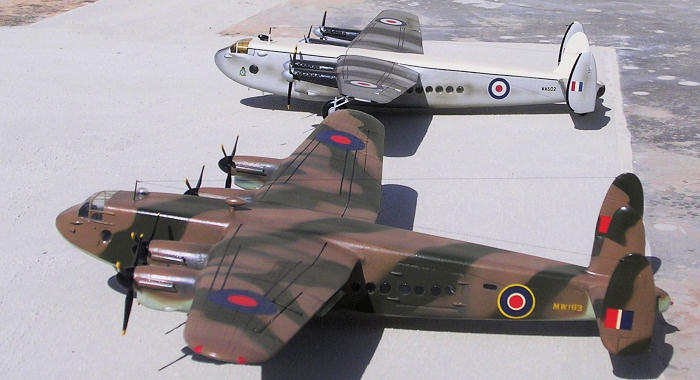
During the first two
years of WWII there was little interest taken By the Air Ministry in the
development of transport aircraft for the RAF, the Air Staff’s efforts being
almost confined entirely rightly to improvement of fighters and bombers.
Transport operations were undertaken by a mixture of converted obsolescent
bombers, flying boats and impressed civil aircraft and American aircraft had
been ordered to supplant them. It is tribute to Avro’s chief designer, Roy
Chadwick that in 1941 he foresaw the need for a long range, four engined
transport aircraft and proceed to redesign the
Lancaster
bomber. In a remarkable short time of 5 months, the prototype
York
LV626 flew for the first time on
5th July 1942
from Ringway. This made use of a
Lancaster
wings, Rolls
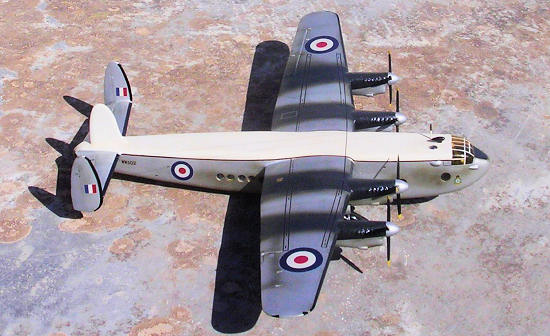 Royce
Merlin power plants, undercarriage and tail assembly. Merged to a completely new
fuselage of tapering square section, that doubles the
Lancaster’s
capacity had been designed, considerably altering the aircraft’s characteristic
appearance.
Royce
Merlin power plants, undercarriage and tail assembly. Merged to a completely new
fuselage of tapering square section, that doubles the
Lancaster’s
capacity had been designed, considerably altering the aircraft’s characteristic
appearance.
Trials at Boscombe Downs followed,
successfully followed by 3 more prototypes. Still production was slow in getting
under way because of shortages of materials and need for priority to the
Lancaster.
One immediate need that the
York
fulfilled was as a
VIP
Transport. The third prototype LV633, named ‘Ascalon’ was allocated as Mr
Winston Churchill’s personal flying conference room and was luxuriously fitted
out having fewer square windows instead of the characteristic row of circular
ones. It also featured a third central fin, which was adopted as standard on all
subsequent
Yorks.
Later
VIP
versions of the
York
were supplied for personal use of Field Marshal Jan Smuts, General De Gaulle and
the Duke of
Gloucester
and lord Lewis Mountbatten.
The
York
Ascalon was delivered to No 24 Squadron at Northolt in March 1943. It carried
Churchill to
Algiers
in May and just a few days later it carried George VI for his first visit to
troops in
North Africa.
Production of the
York
C Mk1 built up slowly and other
VIP
version were delivered. Five early aircraft delivered to BOAC for service from
April 1944 and a further 25 were delivered from August 1945 for Joint operations
with transport command. During 1945 No 511Sqn at Lyneham became the first unit
to receive a full complement of
Yorks
and eventually 108 Sqn flew the aircraft in RAF service. 7 of these squadrons
were equipped in time to perform 29,000 sorties in
Berlin
Airlift from
1st July 1948.
Production ceased with delivery of 257th
York
on
29th April 1948.
Total production comprised 4 prototypes, 208 aircraft for the RAF and 45 civil
aircraft. The latter with 1620 HP Merlin 502 engines. There
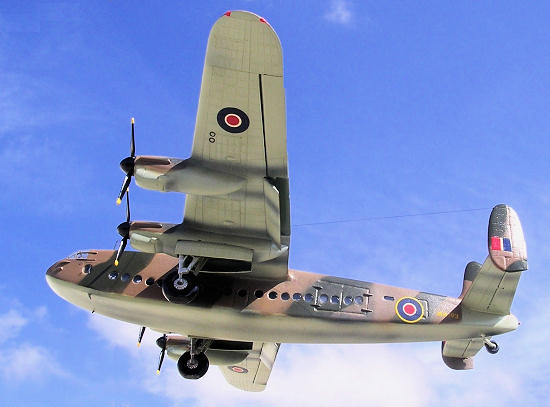 were 25
aircraft for BOAC, 12 for British South American Airways Corporation, 5 for FAMR
of
Argentina
and 2 for
UK
based Skyways. One
York
was built in
Canada,
4 were bought from the RAF in April 1947 for use with the French Aeronaval with
Transport Flight 31S and were not retired until 1963. In due course
Yorks
were operated by several airlines including Scottish Aviation Limited, Hunting
Air Transport Limited, Dan Air Ltd, Eagle Aviation Ltd. Skyways Air Freight
remained the largest
York
operator, even augmenting the fleet with a few ex-RAF
Yorks.
These were used on Colonial Coach service between
London,
Malta
and
Cyprus
until 1957.
were 25
aircraft for BOAC, 12 for British South American Airways Corporation, 5 for FAMR
of
Argentina
and 2 for
UK
based Skyways. One
York
was built in
Canada,
4 were bought from the RAF in April 1947 for use with the French Aeronaval with
Transport Flight 31S and were not retired until 1963. In due course
Yorks
were operated by several airlines including Scottish Aviation Limited, Hunting
Air Transport Limited, Dan Air Ltd, Eagle Aviation Ltd. Skyways Air Freight
remained the largest
York
operator, even augmenting the fleet with a few ex-RAF
Yorks.
These were used on Colonial Coach service between
London,
Malta
and
Cyprus
until 1957.
Both military and civil
Yorks
made frequent use of the airfield at
Hal-Luqa,
Malta.
Whereas none of the military Yorks in RAF service were listed as being involved
in accidents, not the same can be said about the civil types visiting Hal-Luqa.
In fact there were three York accidents. On 13.4.54 a Scottish Aviation York
G-AMUM came to grief beyond repair; on 18.2.56 Scottish Aviation York G-ANSY
exploded on impact soon after an aborted take off making a shallow dive over the
village of Zurrieq with no survivors of the 50 on board the aircraft and on
25.5.58 a Dan Air York G-AMUT overrun runway 06, no fatalities.
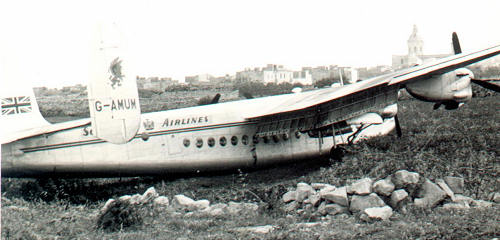 A
typical history of a military York in RAF service is that of MW183, which is
being represented in kit build. This York was a Ringway built 2.6.45 and
delivered to 511 Sqn 13,6,45 transferring to 246 Sqn21.3.46 and coded VU-R. A
category AC flying accident 12.10.46 was re-assessed to cat A and aircraft
repaired by unit prior transfer to No 511 Sqn 31.10.46.. Then went to Avro
Langar for major inspection 9.1.47-8.4.48. To No22 MU 9.4.48 for storage during
which to AST Hamble for modifications 20.12.48-28.2.49. To Abingdon 2.3.49 for
‘PLAINFARE’ on completion of which sent to No 23 MU27.9.49 for storage.
Refurbished by Fairey Ringway 30.4.51-17.1.52, for storage being declared NES
and sold to Surrey Flying Services 22.9.52. Registered G-AMUU.
A
typical history of a military York in RAF service is that of MW183, which is
being represented in kit build. This York was a Ringway built 2.6.45 and
delivered to 511 Sqn 13,6,45 transferring to 246 Sqn21.3.46 and coded VU-R. A
category AC flying accident 12.10.46 was re-assessed to cat A and aircraft
repaired by unit prior transfer to No 511 Sqn 31.10.46.. Then went to Avro
Langar for major inspection 9.1.47-8.4.48. To No22 MU 9.4.48 for storage during
which to AST Hamble for modifications 20.12.48-28.2.49. To Abingdon 2.3.49 for
‘PLAINFARE’ on completion of which sent to No 23 MU27.9.49 for storage.
Refurbished by Fairey Ringway 30.4.51-17.1.52, for storage being declared NES
and sold to Surrey Flying Services 22.9.52. Registered G-AMUU.
The
Contrail kit is a vac-form type made of soft white styrene having side windows
crudely printed to indicate their position on the fuselage. In addition I used a
Revell Avro Lancaster kit so that wings, engines, tail planes and undercarriage
legs could be utilized. Since the old Revell kit had undersize undercarriage I
have replaced it with a set of main wheels issued by Pavla Models set U72-69
1/72 scale.
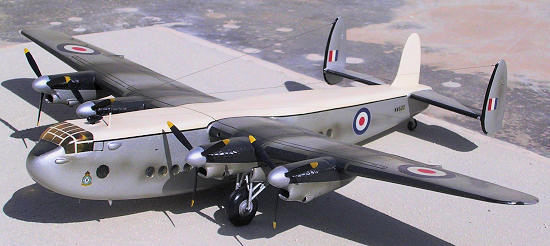 There
are three known ways that one has on offer to build a
York
to a scale of 1/72. Leaving the resin conversion kit apart, which only appeared
in recent years, we are left with two options. A
York
can be built by scratch building a fuselage from wood and merging it with one of
the
Lancaster
kits found on the market. An alternative method is to make use of the Contrail
conversion fuselage and again merge the kit with the rest of parts from a
Lancaster
kit. I made two
York
models; both in RAF service and carried different markings as reflected by the
time these were in service operation. The
York
in post war colours of silver overall with white top was made by first building
a fuselage from yellow pine, moulding cockpit canopy, building side circular
windows on a strip of plastic card which is then joined to the side of the
wooden hollowed fuselage. The alternative method, which is being described in
some detail, was made using the Contrail conversion kit.
There
are three known ways that one has on offer to build a
York
to a scale of 1/72. Leaving the resin conversion kit apart, which only appeared
in recent years, we are left with two options. A
York
can be built by scratch building a fuselage from wood and merging it with one of
the
Lancaster
kits found on the market. An alternative method is to make use of the Contrail
conversion fuselage and again merge the kit with the rest of parts from a
Lancaster
kit. I made two
York
models; both in RAF service and carried different markings as reflected by the
time these were in service operation. The
York
in post war colours of silver overall with white top was made by first building
a fuselage from yellow pine, moulding cockpit canopy, building side circular
windows on a strip of plastic card which is then joined to the side of the
wooden hollowed fuselage. The alternative method, which is being described in
some detail, was made using the Contrail conversion kit.
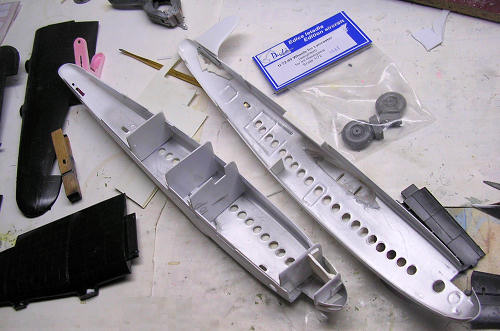 The
two-part fuselage was cut and sanded as if I am building a vac form kit, checked
for correctness in overall length that was 13.08 inches. The length of the kit
was found to be correct but on checking the fuselage width alas it was found to
be too narrow and needed a spacer cut from the backing surplus plastic card to
fill a gap which was ¼ “ at forward cabin area and tapers to 1/8 “ at the rear
of the fuselage. Two strips of styrene were cut and with one being wider
throughout the length these were fixed in a laminated form so that the wider one
will overlap on the inside of fuselage and the narrower one produce the required
width of the model which is flush with the roof. Widening the fuselage for
correctness also meant that the clear canopy that comes with the kit is well
undersize and needed replacement with a newly moulded one. So I used the same
wooden male prepared for the previous
York
I built and produced two in clear acetate, one being spare in the event it comes
handy. The vac form fuselage
windows were drilled and shaped circular using a round file close to the
diameter required. The fuselage contained a number of bulkheads which when
fitted in their respective station they will greatly strengthen the fuselage.
Obviously with the kit fuselage being widened, the ones that came with the kit
were replaced with new wider ones that were cut from backing styrene.
The
two-part fuselage was cut and sanded as if I am building a vac form kit, checked
for correctness in overall length that was 13.08 inches. The length of the kit
was found to be correct but on checking the fuselage width alas it was found to
be too narrow and needed a spacer cut from the backing surplus plastic card to
fill a gap which was ¼ “ at forward cabin area and tapers to 1/8 “ at the rear
of the fuselage. Two strips of styrene were cut and with one being wider
throughout the length these were fixed in a laminated form so that the wider one
will overlap on the inside of fuselage and the narrower one produce the required
width of the model which is flush with the roof. Widening the fuselage for
correctness also meant that the clear canopy that comes with the kit is well
undersize and needed replacement with a newly moulded one. So I used the same
wooden male prepared for the previous
York
I built and produced two in clear acetate, one being spare in the event it comes
handy. The vac form fuselage
windows were drilled and shaped circular using a round file close to the
diameter required. The fuselage contained a number of bulkheads which when
fitted in their respective station they will greatly strengthen the fuselage.
Obviously with the kit fuselage being widened, the ones that came with the kit
were replaced with new wider ones that were cut from backing styrene.
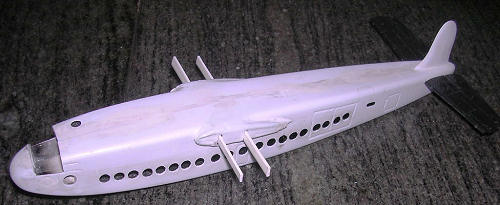 Turning
to the Revell kit of the
Lancaster
bomber this had 3/8” of the wings removed at the wing root. I carefully marked a
parallel line to the end and used an Exacto blade to cut the surplus part to
bring the overall wingspan exactly 17”. Two long wing spars in the shape of
rectangular channels were cut and fitted through the fuselage wing roots through
slots carefully cut in places to receive them. I used Contrail struts for these
spars. Further work included detailing the cockpit crew office to house a pilot
and co pilot. These were at a staggered seating level. Crew seats, scratch built
from styrene, instrument panel, coaming and central console and control wheels
were all added in place and painted in black, white and grey. Freight area was
painted black and so were the four bulkheads glued inside across the fuselage
interior. Fuselage was now closed. The cut canopy was then fitted and glued in
place, using a small amount of Kristal Kleer with the effect that the kit now
started to take shape.
Turning
to the Revell kit of the
Lancaster
bomber this had 3/8” of the wings removed at the wing root. I carefully marked a
parallel line to the end and used an Exacto blade to cut the surplus part to
bring the overall wingspan exactly 17”. Two long wing spars in the shape of
rectangular channels were cut and fitted through the fuselage wing roots through
slots carefully cut in places to receive them. I used Contrail struts for these
spars. Further work included detailing the cockpit crew office to house a pilot
and co pilot. These were at a staggered seating level. Crew seats, scratch built
from styrene, instrument panel, coaming and central console and control wheels
were all added in place and painted in black, white and grey. Freight area was
painted black and so were the four bulkheads glued inside across the fuselage
interior. Fuselage was now closed. The cut canopy was then fitted and glued in
place, using a small amount of Kristal Kleer with the effect that the kit now
started to take shape.
With the fuselage now closed and
set, filler was applied wherever it was needed and panel lines re-scratched, the
rest of the kit follows the Lancaster instruction with the difference that we
have a new fuselage to replace the bomber one. The fuselage had the wings
slotted to it, which were secured with super glue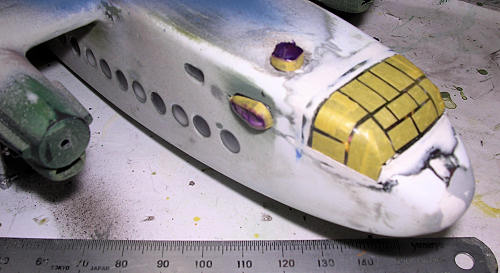 and faired with Plasto putty. The filler was added on a little at a time until a
gradual smooth fillet was created and helped the wings to remain firm in place.
Other detail added included aerials, detail to undercarriage legs, open the side
air intakes mounted on each Merlin engine, three control streaks to ailerons on
both wings added. These were made from stretch sprues. Tail trim tabs were
modified and an astrodome was glued to rooftop aft of cockpit. Wider diameter
main bogies from the ‘Pavla resin set’ replaced the undersize undercarriage
supplied with the Revell kit. These were detailed and had flattened part that
rests on the ground.
and faired with Plasto putty. The filler was added on a little at a time until a
gradual smooth fillet was created and helped the wings to remain firm in place.
Other detail added included aerials, detail to undercarriage legs, open the side
air intakes mounted on each Merlin engine, three control streaks to ailerons on
both wings added. These were made from stretch sprues. Tail trim tabs were
modified and an astrodome was glued to rooftop aft of cockpit. Wider diameter
main bogies from the ‘Pavla resin set’ replaced the undersize undercarriage
supplied with the Revell kit. These were detailed and had flattened part that
rests on the ground.
I consider this kit conversion
rather a straightforward kit build if compared to one where the kit had to be a
completely vac form type, or as was the case of my earlier York kit where the
fuselage was made of wood. In this case widening the fuselage was the only
setback. Careful measurement of the fuselage width sorted this problem.
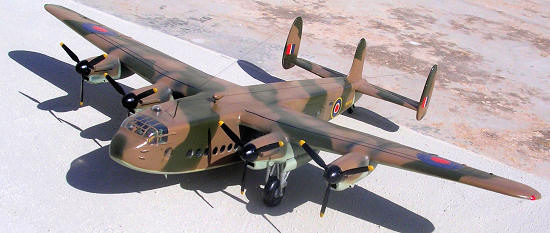 The
prototypes and production aircraft produced during the war and for an initial
peacetime period all had the upper surface finished in the standard dark green
and dark earth camouflage. The camouflage pattern issued with the Contrail kit
instructions appeared to conform to that I have seen in photos of the same
aircraft I built. York MW183 was a production type, which had sky blue underside
and carried C1 roundels. Later peacetime production were painted overall using
lightweight aluminium silver coloured dope with D type roundels and fin flashes.
Serials were black or yellow.
VIP
aircraft were stripped of paint and the metal surfaces highly polished. Later
examples of York also had a fuselage blue trim with the upper fuselage painted
white. This was an asset for Yorks operating in the Near and Far East region to
cut down heat absorption. Roundel decals and fin flashes came from the Revell
kit while small serials were picked from decal spares box.
The
prototypes and production aircraft produced during the war and for an initial
peacetime period all had the upper surface finished in the standard dark green
and dark earth camouflage. The camouflage pattern issued with the Contrail kit
instructions appeared to conform to that I have seen in photos of the same
aircraft I built. York MW183 was a production type, which had sky blue underside
and carried C1 roundels. Later peacetime production were painted overall using
lightweight aluminium silver coloured dope with D type roundels and fin flashes.
Serials were black or yellow.
VIP
aircraft were stripped of paint and the metal surfaces highly polished. Later
examples of York also had a fuselage blue trim with the upper fuselage painted
white. This was an asset for Yorks operating in the Near and Far East region to
cut down heat absorption. Roundel decals and fin flashes came from the Revell
kit while small serials were picked from decal spares box.
I must admit I enjoyed
making this model in particular and am very pleased with the result. It has a
special place as the York brings many happy memories of my early childhood. Even
though I lived some 2 miles from Hal-Luqa airfield, the York low rate of climb
made them fly very low barely 1,500 feet with the tremendous noise of four
Merlin engines going at full blast as they flew by over the town of Marsa.
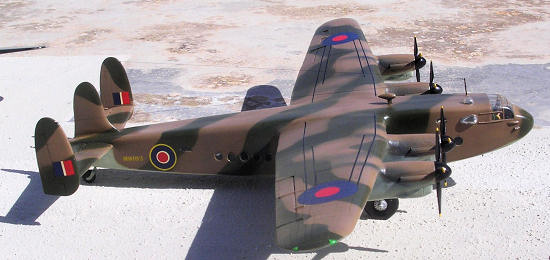 1. Avro
York mini-monograph by Chris Ashworth.
1. Avro
York mini-monograph by Chris Ashworth.
2. Local (Malta) aviation history
data via Aviation Museum at Ta’Qali.
Carmel J.
Attard
October 2010
Thanks to me and my fondness for anything different from
the norm for this one.
If you would like your product reviewed fairly and quickly, please
contact
me or see other details in the
Note to
Contributors.
Back to the Main Page
Back to the Review
Index Page


 Royce
Merlin power plants, undercarriage and tail assembly. Merged to a completely new
fuselage of tapering square section, that doubles the
Royce
Merlin power plants, undercarriage and tail assembly. Merged to a completely new
fuselage of tapering square section, that doubles the  were 25
aircraft for BOAC, 12 for British South American Airways Corporation, 5 for FAMR
of
were 25
aircraft for BOAC, 12 for British South American Airways Corporation, 5 for FAMR
of  A
typical history of a military York in RAF service is that of MW183, which is
being represented in kit build. This York was a Ringway built 2.6.45 and
delivered to 511 Sqn 13,6,45 transferring to 246 Sqn21.3.46 and coded VU-R. A
category AC flying accident 12.10.46 was re-assessed to cat A and aircraft
repaired by unit prior transfer to No 511 Sqn 31.10.46.. Then went to Avro
Langar for major inspection 9.1.47-8.4.48. To No22 MU 9.4.48 for storage during
which to AST Hamble for modifications 20.12.48-28.2.49. To Abingdon 2.3.49 for
‘PLAINFARE’ on completion of which sent to No 23 MU27.9.49 for storage.
Refurbished by Fairey Ringway 30.4.51-17.1.52, for storage being declared NES
and sold to Surrey Flying Services 22.9.52. Registered G-AMUU.
A
typical history of a military York in RAF service is that of MW183, which is
being represented in kit build. This York was a Ringway built 2.6.45 and
delivered to 511 Sqn 13,6,45 transferring to 246 Sqn21.3.46 and coded VU-R. A
category AC flying accident 12.10.46 was re-assessed to cat A and aircraft
repaired by unit prior transfer to No 511 Sqn 31.10.46.. Then went to Avro
Langar for major inspection 9.1.47-8.4.48. To No22 MU 9.4.48 for storage during
which to AST Hamble for modifications 20.12.48-28.2.49. To Abingdon 2.3.49 for
‘PLAINFARE’ on completion of which sent to No 23 MU27.9.49 for storage.
Refurbished by Fairey Ringway 30.4.51-17.1.52, for storage being declared NES
and sold to Surrey Flying Services 22.9.52. Registered G-AMUU.  There
are three known ways that one has on offer to build a
There
are three known ways that one has on offer to build a  The
two-part fuselage was cut and sanded as if I am building a vac form kit, checked
for correctness in overall length that was 13.08 inches. The length of the kit
was found to be correct but on checking the fuselage width alas it was found to
be too narrow and needed a spacer cut from the backing surplus plastic card to
fill a gap which was ¼ “ at forward cabin area and tapers to 1/8 “ at the rear
of the fuselage. Two strips of styrene were cut and with one being wider
throughout the length these were fixed in a laminated form so that the wider one
will overlap on the inside of fuselage and the narrower one produce the required
width of the model which is flush with the roof. Widening the fuselage for
correctness also meant that the clear canopy that comes with the kit is well
undersize and needed replacement with a newly moulded one. So I used the same
wooden male prepared for the previous
The
two-part fuselage was cut and sanded as if I am building a vac form kit, checked
for correctness in overall length that was 13.08 inches. The length of the kit
was found to be correct but on checking the fuselage width alas it was found to
be too narrow and needed a spacer cut from the backing surplus plastic card to
fill a gap which was ¼ “ at forward cabin area and tapers to 1/8 “ at the rear
of the fuselage. Two strips of styrene were cut and with one being wider
throughout the length these were fixed in a laminated form so that the wider one
will overlap on the inside of fuselage and the narrower one produce the required
width of the model which is flush with the roof. Widening the fuselage for
correctness also meant that the clear canopy that comes with the kit is well
undersize and needed replacement with a newly moulded one. So I used the same
wooden male prepared for the previous  Turning
to the Revell kit of the
Turning
to the Revell kit of the  and faired with Plasto putty. The filler was added on a little at a time until a
gradual smooth fillet was created and helped the wings to remain firm in place.
Other detail added included aerials, detail to undercarriage legs, open the side
air intakes mounted on each Merlin engine, three control streaks to ailerons on
both wings added. These were made from stretch sprues. Tail trim tabs were
modified and an astrodome was glued to rooftop aft of cockpit. Wider diameter
main bogies from the ‘Pavla resin set’ replaced the undersize undercarriage
supplied with the Revell kit. These were detailed and had flattened part that
rests on the ground.
and faired with Plasto putty. The filler was added on a little at a time until a
gradual smooth fillet was created and helped the wings to remain firm in place.
Other detail added included aerials, detail to undercarriage legs, open the side
air intakes mounted on each Merlin engine, three control streaks to ailerons on
both wings added. These were made from stretch sprues. Tail trim tabs were
modified and an astrodome was glued to rooftop aft of cockpit. Wider diameter
main bogies from the ‘Pavla resin set’ replaced the undersize undercarriage
supplied with the Revell kit. These were detailed and had flattened part that
rests on the ground. The
prototypes and production aircraft produced during the war and for an initial
peacetime period all had the upper surface finished in the standard dark green
and dark earth camouflage. The camouflage pattern issued with the Contrail kit
instructions appeared to conform to that I have seen in photos of the same
aircraft I built. York MW183 was a production type, which had sky blue underside
and carried C1 roundels. Later peacetime production were painted overall using
lightweight aluminium silver coloured dope with D type roundels and fin flashes.
Serials were black or yellow.
The
prototypes and production aircraft produced during the war and for an initial
peacetime period all had the upper surface finished in the standard dark green
and dark earth camouflage. The camouflage pattern issued with the Contrail kit
instructions appeared to conform to that I have seen in photos of the same
aircraft I built. York MW183 was a production type, which had sky blue underside
and carried C1 roundels. Later peacetime production were painted overall using
lightweight aluminium silver coloured dope with D type roundels and fin flashes.
Serials were black or yellow.  1. Avro
York mini-monograph by Chris Ashworth.
1. Avro
York mini-monograph by Chris Ashworth.